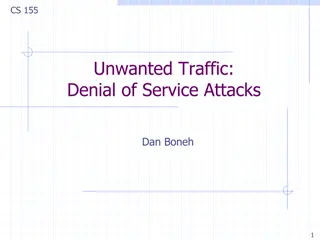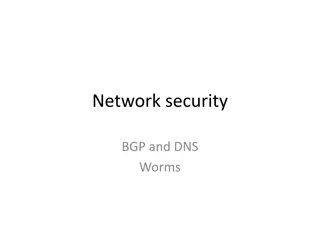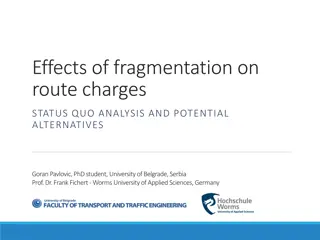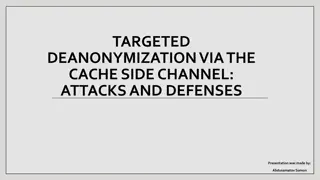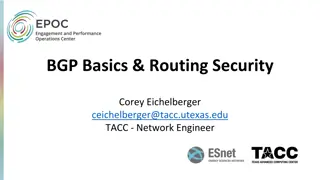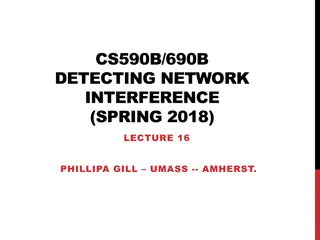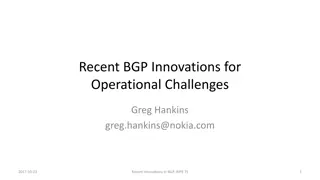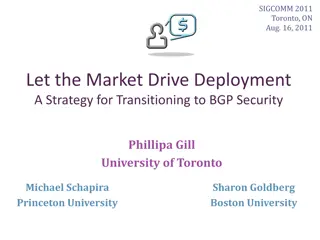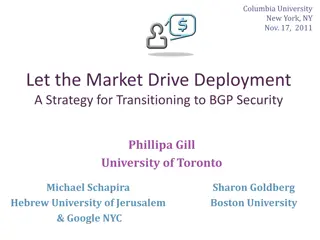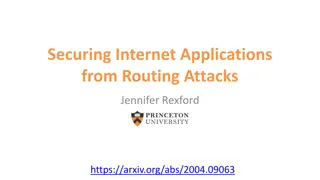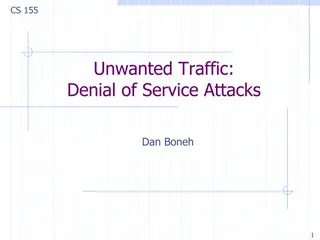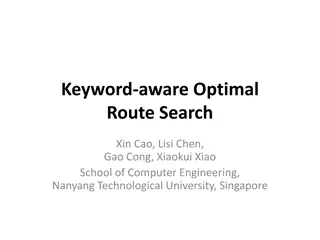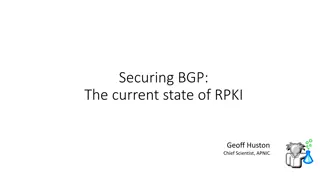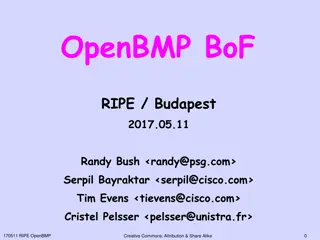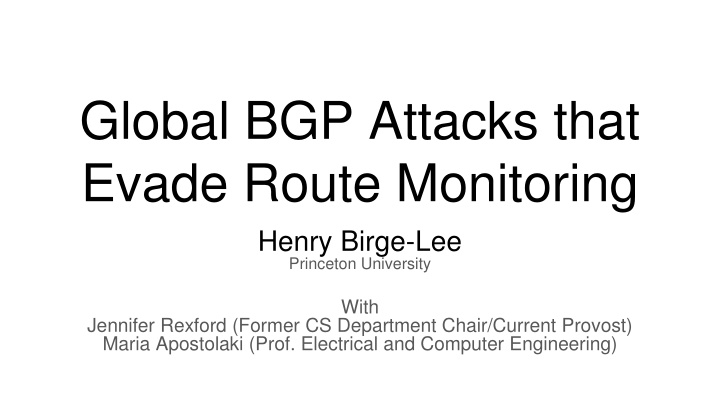
Stealthy BGP Attacks and Route Monitoring
Explore the intricate world of stealthy BGP attacks that evade route monitoring, as discussed by Henry Birge-Lee, Jennifer Rexford, and Maria Apostolaki. Discover the importance of BGP monitoring, the motivation behind studying stealthy attacks, and the key metrics used to assess the stealthiness of such attacks.
Download Presentation

Please find below an Image/Link to download the presentation.
The content on the website is provided AS IS for your information and personal use only. It may not be sold, licensed, or shared on other websites without obtaining consent from the author. If you encounter any issues during the download, it is possible that the publisher has removed the file from their server.
You are allowed to download the files provided on this website for personal or commercial use, subject to the condition that they are used lawfully. All files are the property of their respective owners.
The content on the website is provided AS IS for your information and personal use only. It may not be sold, licensed, or shared on other websites without obtaining consent from the author.
E N D
Presentation Transcript
Global BGP Attacks that Evade Route Monitoring Henry Birge-Lee Princeton University With Jennifer Rexford (Former CS Department Chair/Current Provost) Maria Apostolaki (Prof. Electrical and Computer Engineering)
Overview 1. Motivation and Terminology 2. Background 3. Launching the Attack in the Real World 4. Attack Viability 5. Countermeasures
What is BGP monitoring and why is it important 1. Using a combination public (e.g., RIPE NCC RIS) and/or private data feeds to observe global BGP updates 2. Monitoring can identify BGP attacks for real time responses/mitigations or after-the-fact incident investigation 3. BGP monitoring systems are coming to play a large role in routing security given the relatively slow adoption of high-security interdomain routing protocols (e.g., BGPSEC)
Why are we are interested in stealthy BGP attacks 1. If you can make your attack stealthy you can (potentially) evade detection and mitigation 2. Stealthy attacks are possible and studied by prior work Birge-Lee et al. 19 SICO https://doi.org/10.1145/3319535.3363197 Milolidakis et al. 23 On the Effectiveness of BGP Hijackers That Evade Public Route Collectors," https://doi.org/10.1109/ACCESS.2023.3261128 Morillo et al. 21 ROV++ https://dx.doi.org/10.14722/ndss.2021.24438
Exactly what do we mean by stealthy attack 1. Many different metrics: a. How much of the Internet sees your route? b. Do attack detection algorithms think your attack is just background noise? N.A. for this talk c. Do networks using the route see the route? also achieved by our attack d. Do BGP monitoring services see the route? (focus of today s talk)
Other ASes Terminology BGP Monitoring Vantage Point I announce 2.2.2.0/23 BGP Monitoring Vantage Point BGP Monitoring Vantage Point AS 174 Client Network S o Paulo Datacenter Adversary
Other ASes Terminology BGP Monitoring Vantage Point I announce 2.2.2.0/23 BGP Monitoring Vantage Point BGP Monitoring Vantage Point AS Client Network S o Paulo Datacenter Equally-specific attack: announce 2.2.2.0/23 Subprefix attack: announce 2.2.2.0/24 Adversary
Overview 1. Motivation and Terminology 2. Background 3. Launching the Attack in the Real World 4. Attack Viability 5. Countermeasures
Work to Date on Stealthy Attacks 1. Use an equally-specific BGP attack and shaping your announcement (BGP communities/AS-path poisoning) to avoid public monitors a. Upside: Viable (Birge-Lee et al. 19 SICO; Milolidakis et al. 21 Smart BGP Hijacks) b. Downside: Lot of monitors means only a small portion of the uses the malicious route c. Downside: Networks using the malicious route (source victims) see it in their tables 2. Use a subprefix attack and stop it from spreading to the source victim a. Upside: Source victims have not knowledge of the malicious route they are using (Morillo et al. 21 ROV++) b. Downside: Subprefix attacks spread all over the Internet, not stealthy at all from public monitors SICO: Surgical Interception Attacks by Manipulating BGP Communities https://dl.acm.org/doi/10.1145/3319535.3363197 ROV++: Improved Deployable Defense against BGP Hijacking https://www.ndss-symposium.org/ndss-paper/rov-improved-deployable- defense-against-bgp-hijacking/ A. Milolidakis, T. B hler, K. Wang, M. Chiesa, L. Vanbever and S. Vissicchio, "On the Effectiveness of BGP Hijackers That Evade Public Route Collectors," in IEEE Access, vol. 11, pp. 31092-31124, 2023, https://doi.org/10.1109/ACCESS.2023.3261128
Real-world Stealthy Attacks 1. Adversary established direct peering with source victim (Yahoo mail) at DE-CIX 2. Announced malicious subprefix only over direct peering a. Avoided all BGP monitors 3. Was eventually caught via coordination from prefix owner and Yahoo a. Yahoo confirmed that the networks in their table were not the same as the networks announced by the prefix owner 4. Attack was limited in spread and could not be scaled: only spread to Yahoo Invisible_Hijacking https://ripe72.ripe.net/presentations/45-Invisible_Hijacking.pdf
Current beliefs on stealthy attacks Although higher-Type attacks [i.e., attacks with more AS prepends] may sometimes be completely stealthy to the infrastructure (e.g., in 21% of the attacks for the Type-4 simulations), such hijackers could not affect while remaining stealthy more than 2% of the Internet. [1] [1] A. Milolidakis, T. B hler, K. Wang, M. Chiesa, L. Vanbever and S. Vissicchio, "On the Effectiveness of BGP Hijackers That Evade Public Route Collectors," in IEEE Access, vol. 11, pp. 31092-31124, 2023, https://doi.org/10.1109/ACCESS.2023.3261128
Current beliefs on stealthy attacks Although higher-Type attacks [i.e., attacks with more AS prepends] may sometimes be completely stealthy to the We achieve an attack that: infrastructure (e.g., in 21% of the attacks for the Type-4 affects the vast majority of the Internet is seen by zero BGP monitors is not in the routetable of affected networks simulations), such hijackers could not affect while remaining stealthy more than 2% of the Internet. [1] [1] A. Milolidakis, T. B hler, K. Wang, M. Chiesa, L. Vanbever and S. Vissicchio, "On the Effectiveness of BGP Hijackers That Evade Public Route Collectors," in IEEE Access, vol. 11, pp. 31092-31124, 2023, https://doi.org/10.1109/ACCESS.2023.3261128
Overview 1. Motivation and Terminology 2. Background 3. Launching the Attack in the Real World 4. Attack Viability 5. Countermeasures
Key Attack Insight BGP communities are 32-bit tags attached to BGP routes which can impact how routers propagate BGP announcements The RFC that introduced BGP communities (RFC 1997) defined several well-known communities including NO_EXPORT which tells routers not to propagate a BGP announcement outside of their own AS The NO_EXPORT community (supported out of the box by routers) prohibits the exporting of a route to BGP monitoring even if a network is a direct peer of a BGP monitoring service Previous work on stealthy BGP attacks assumes if a network is a peered with a monitoring service, it will send all routes it uses to the monitoring service This insight overcomes this allowing for much more effective stealthy attacks
Differentiation with previous work Our work: peer networks do not share their routes with monitoring services Previous work: if malicious route is used by peer network, monitoring service sees route Peering router sees RRC25 as external AS; applies NO_EXPORT RIPE RIS RRC25 AS 174 Cogent RIPE RIS RRC25 AS 174 Cogent Malicious BGP announcement propagation with NO_EXPORT Malicious BGP announcement propagation
Attack Steps 1. Announce a malicious sub-prefix of your victim s prefix to a major transit provider (attacker needs to social engineer or otherwise bypass prefix filters) 2. Attach the RFC NO_EXPORT community to your announcement a. Currently BGP monitoring services work by establishing eBGP sessions with peers (e.g., major transit networks that provide route tables to the monitoring service) b. To these the routers that run these sessions, the sessions appear to be standard eBGP sessions to what looks like a remote network, thus the RFC NO_EXPORT community applies 3. The malicious route will be installed in a major transit provider (optimally your victim s upstream) 4. The malicious route will not be sent to BGP monitoring
All real world attacks were conducted ethically 1. Hijack ourselves approach (we controlled IP prefix) 2. All nodes (including adversary ) were authorized to announce route 3. No real services on prefix used in experiment
Other ASes Benign Setup BGP Monitoring Vantage Point 2604:4540:82::/47 BGP Monitoring Vantage Point BGP Monitoring Vantage Point AS 174 Client Network S o Paulo Silicon Valley Datacenter Routing Not Under Attack Flow of Client s Network Traffic
Standard sub- prefix attack Other ASes BGP Monitoring Vantage Point 2604:4540:82::/47 BGP Monitoring Vantage Point BGP Monitoring Vantage Point AS 174 Cogent Client Network S o Paulo Silicon Valley Datacenter Non-stealthy Routing Attack Flow of Client s Network Traffic Propagation of Adversary s Malicious Announcement Network With Adversary s Route Installed 2604:4540:82::/48
Standard subprefix attack is seen everywhere ris_subscribe_ok {'subscription': {'prefix': '2604:4540:82::/48', 'moreSpecific': True, 'lessSpecific': False}, 'socketOptions': {'includeRaw': True, 'acknowledge': True}} ris_message {'timestamp': 1663691310.63, 'peer': '2001:978:4::b', 'peer_asn': '174', 'id': '25-28178-16349017', 'host': 'rrc25', 'type': 'UPDATE', 'path': [174, 20473], 'origin': 'igp', 'med': 78041, 'announcements': [{'next_hop': '2001:978:4::b', 'prefixes': ['2a0e:97c6:5226::/48', '2a0e:97c6:506d::/48', '2604:4540:82::/48']}]
Stealthy sub- prefix attack Other ASes BGP Monitoring Vantage Point 2604:4540:82::/47 BGP Monitoring Vantage Point BGP Monitoring Vantage Point AS 174 Cogent Client Network S o Paulo Silicon Valley Datacenter Stealthy Routing Attack 2604:4540:82::/48 Flow of Client s Network Traffic Community: NO_EXPORT (RFC 1997 or 174:990 for Cogent) Propagation of Adversary s Malicious Announcement Network With Adversary s Route Installed
Stealthy attack is seen nowhere ris_subscribe_ok {'subscription': {'prefix': '2604:4540:82::/48', 'moreSpecific': True, 'lessSpecific': False}, 'socketOptions': {'includeRaw': True, 'acknowledge': True}}
100% of Internet was affected by stealthy route 1. Ran a ping scan to a 1k randomly selected ping hosts 2. Source IP address of the scan was within the hijacked prefix a. I.e., Hosts responded to either victim or adversary depending on whether they were affected by the attack 3. In scan, 100% of responses went to adversary a. Prefix owner exclusively used Cogent for transit 4. See attack demo video for more: https://drive.google.com/file/d/19Cr0JNRXeYqlWKoPR8K39JlDImlnPmC4/vie w?usp=sharing
Overview 1. Motivation and Terminology 2. Background 3. Launching the Attack in the Real World 4. Attack Viability 5. Countermeasures
How many networks have this behavior Network Cogent Telia NTT Sprint Many thanks to: Supports NO_EXPORT Yes Yes Yes Yes RGNet Edge Princeton OIT BGP Monitoring Session with RIPE RIS Yes Yes Yes Yes Suppressed session with RIPE Yes Yes Yes Yes Invisible from Thousandeyes Yes Yes Yes Yes Invisible from Cisco Crosswork Cloud Yes Yes Yes Yes
How much of the Internet is hijackable via these networks 1. Ran simulations of AS-level paths between 150 random ASes using the CAIDA topology 2. Just assuming an adversary installed a malicious route in the networks from the previous slide, picked a random victim AS s prefix to hijack, the adversary would affect traffic from 23% source ASes on the Internet (on average) 3. If an adversary instead chooses the top 5 largest ASes by customer cone, (3356, 1299, 174, 2914, 6762), on average it could hijack traffic from 39% of source ASes a. previous work on stealthy hijacks 2% of Internet traffic (90th percentile) and median case is < .2% 4. A strategic adversary could do even better (e.g., 100% like in our experiment)
How viable is a subprefix attack 1. RPKI can prevent subprefix attacks a. RPKI ROAs specify proper prefix length, announcements for other prefix lengths are blocked b. ROAs now cover ~50% of IP prefixes, ~50% still not protected c. Of the ~50% of IP prefixes covered by RPKI, about 36% (18% of total) have an improper maxLength attribute leaving them still vulnerable to sub-prefix attacks [1] [2] 2. My 2023 Usenix Security Paper [2] How Effective is Multiple-Vantage-Point Domain Control Validation? looked at TLS domains and found only %29.2 had all A record and Nameserver IPs protected against subprefix attacks a. About half of these protected domains (15.2%) ran exclusively out of /24 announcements. Only %18.2 of domains were protected because of RPKI. 3. Even with great RPKI progress, subprefix attacks are still highly viable (massive numbers in the wild each year) [1] Yossi Gilad, Omar Sagga, and Sharon Goldberg. 2017. MaxLength Con- sidered Harmful to the RPKI. In International Conference on Emerging Networking EXperiments and Technologies (Incheon, Republic of Korea) (CoNEXT). Association for Computing Machinery, New York, NY, USA, 101 107. https://doi.org/10.1145/3143361.3143363
Would a major network really propagate a malicious route directly from a customer? 1. Unfortunately: Yes 2. Some examples: a. AS3266: BitCanal hijack factory, courtesy of Cogent, GTT, and Level3 https://mailman.nanog.org/pipermail/nanog/2018-June/096034.html b. I guess AS1299 Arelion doesn't check if the origin AS of an announcement is in the customer's AS-SET but it's pretty normal and understandable. https://mailman.nanog.org/pipermail/nanog/2022-August/220320.html c. As such, it seems likely a peer or customer of AS6461 [Zayo] was [launching BGP hijacks]. https://mailman.nanog.org/pipermail/nanog/2022-February/217602.html 3. Know your customer is important but only effective to an extent because it does not rely on true cryptographic identifiers.
Overview 1. Motivation and Terminology 2. Background 3. Launching the Attack in the Real World 4. Attack Viability 5. Countermeasures
Countermeasures 1. Networks need to not allow customer-applied NO_EXPORT to control exporting behavior to route monitoring a. Customer networks should not decide what is sent to BGP monitoring b. Option 1: Translate RFC NO_EXPORT to a different AS-specific use community that only applies to normal BGP neighbors and not route monitoring c. Option 2: Run BGP monitoring over iBGP sessions i. Currently used by kentik, still appears to not be pervasive enough to catch our sample attacks ii. Still vulnerable to NO_ADVERTISE d. Option 3: Move monitoring to BMP (optimal long term) e. Option 4: Vender support flag (e.g., route_monitor_session BGP config flag)
Config Changes to Major Networks (option 1 rewriting) (pseudo config for AS 1234) filter route_in { if (NO_EXPORT) in bgp_community then { bgp_community.delete([NO_EXPORT]); bgp_community.add(1234:997); } if (NO_EXPORT_SUBCONF) in bgp_community then { bgp_community.delete([NO_EXPORT_SUBCONF]); bgp_community.add(1234:998); } if (NO_ADVERTISE) in bgp_community then { bgp_community.delete([NO_ADVERTISE]); bgp_community.add(1234:999); } accept;} filter bgp_neighbor_out { if (1234:997 or 1234:998 or 1234:999) in bgp_community then { reject; } accept;} filter ripe_routeviews_out {accept;}
Config Changes to Major Networks (option 2 iBGP) (pseudo config for AS 1234) protocol bgp routeviews { local as 1234; neighbor 10.142.12.6 as 1234; # RIPE/Routeviews could be configured to establish iBGP sessions using peer ASNs import none; export all; filter next hop self; # Don t leak internal nexthop details to RIPE/RotueViews } RIPE NCC Admins: Please consider iBGP sessions with peers (this is highly viable and already used by Kentik s BGP monitoring https://kb.kentik.com/v0/Bd01.htm#Bd01-Router_BGP_Considerations )
Interest at Networks Among US R&E networks: ESNet and Internet 2 are considering deploying countermeasures Any networks interested in deploying countermeasures for NO_EXPORT please reach out ( birgelee@princeton.edu ) See our technical report for more details https://arxiv.org/abs/2408.09622
Questions Henry Birge-Lee Research Software Engineer Princeton Electrical Engineering and Computer Science birgelee@princeton.edu https://henrybirgelee.com



